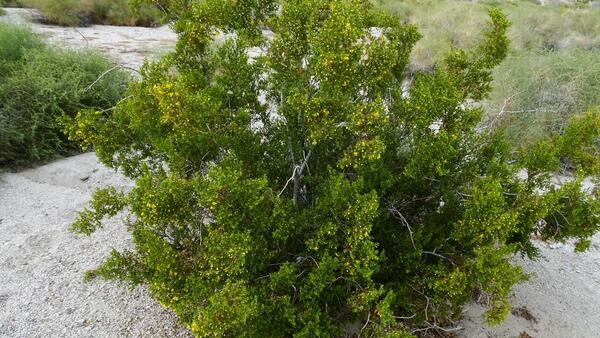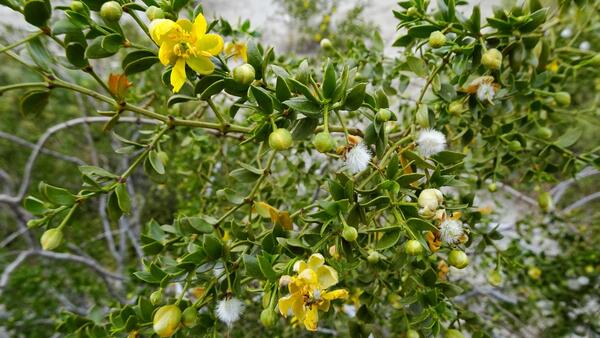How did creosote bushes come to the desert?
“There is in all things a pattern that is part of our universe. It has symmetry, elegance, and grace - these qualities you find always in that the true artist captures. You can find it in the turning of the seasons, the way sand trails along a ridge, in the branch clusters of the creosote bush of the pattern of its leaves…” — Frank Herbert
Creosote bushes, Larrea tridentata, dominate four of the five North American Deserts; only the Great Basin Desert is without creosote. Across the Chihuahua, Sonora, and Colorado, and Mojave Deserts creosote is the dominant shrub. No other plant can claim such a wide desert distribution, adapting to the summer rain in the Chihuahua Desert, summer and winter rain in the Sonoran Desert, and the mostly winter rains of both the Colorado and Mojave Deserts (although the uncommon late summer rains there seem to be a key to their successful recruitment.) Heat is not a hinderance, only the cold winters of the Great Basin Desert and the regular wildfires in desert grasslands and in non-desert habitats seem to stymie the ability of creosote to thrive.
There are many interesting aspects of creosote bush ecology, but none more curious as how they came to exist in the North American Deserts. The closest relative of the North American creosote is Larrea divaricata, a species restricted to the arid lands of Argentina. Our creosote and those in Argentina are visually nearly identical, although the genetics clearly separate them. Additionally, Argentina has several other species of Larrea distributed across the Pampas; clearly Argentina is where creosote evolved, long before the Isthmus of Panama connected North and South America. This presents a challenging biogeography question; how did our creosote get this far north? No one has a definitive answer, but I have a hypothesis. That first creosote seed would have had to cross the Amazon Basin, a tropical forest crossed with multiple rivers, some more than a mile wide, none of which could have supported an arid-adapted species such as creosote. Somehow that creosote seed was able to rapidly cross the Amazon Basin and reach the southern edge of the Chihuahuan Desert, a distance of at least 5,500 miles. The prevailing wind currents or hurricane paths do not match the route that seed would have needed to travel. Someone or something would have needed to carry that seed through or above that vast tropical expanse.
As it turns out, Swainson’s Hawks migrate north each spring and then back south each fall between the Argentine Pampas and the North American Deserts, nonstop or with just nighttime roosts, along the exact path that seed would have needed to travel. Except this bird is not a seed eater. Any bird that purposefully ate creosote seeds would digest them, rendering the seeds unable to germinate in a new land. Rather Swainson’s Hawks eat small mammals, reptiles, and amphibians. My hypothesis is that in preparation for its northward migration a Swainson’s Hawk gorged on small mammals, one or more of which had just eaten a creosote seed. Because hawks and owls (and insect-eating birds) tend to swallow small prey whole, they need to digest just the meaty parts of those prey and then cough up a pellet of the otherwise undigestible hair, scales, bones, and seeds. My hypothesis just requires that for the Swainson’s Hawk to reach the southern Chihuahua Desert and then cough up the hair, bones and at least one creosote seed.
Evidence from pack rat middens supports my hypothesis in that the first earliest evidence of creosote bushes in North America occurred in the southern Chihuahua Desert. Paleoecologists have found that desert pack rats occupy the same houses of sticks and leaves and cactus joints (middens) for hundreds and perhaps thousands of years. Over those years and many generations of pack rats, each layer of plant parts the rat collected would become entombed in crystalized rat urine. By sampling the layers of the rat homes and analyzing each layer with carbon-14 dating, the paleoecologists can describe how the plant diversity surrounding that pack rat home has changed over tens of thousands of years. Using this approach, we know that the first North American creosote appeared in the southern Chihuahua Desert and then from there rapidly spread into the warm deserts of North America. Using pack rat midden carbon-14 analyses, the first creosote collected by a pack rat in the Chihuahua Desert occurred about 109,000 years ago.
Using modern DNA analyses, scientists have developed a genetic “clock,” by measuring the average number of random mutations that occur in a species’ DNA over time. Using this approach, scientists believe our North American creosote diverged from its closest relative in Argentina some 3.3 to 4.2 million years ago. Obviously, the DNA versus the carbon-14 dating numbers do not match. Perhaps that first creosote seed to reach North America mutated faster than expected having been deposited in a completely new land, new climate, and with new species to interact with. Another possible cause for the chronological mismatch is that the first creosote population would have likely needed many thousands of years to grow to be large enough for that pack rat to then find one and add those sticks and leaves to its home. One more possible explanation is that carbon-14 dating accuracy is good at the tens of thousands of years range but becomes less accurate at hundreds of thousands and especially millions of years’ time spans.
While we can’t be exactly sure when that first creosote seed sent down roots in North America, they have been here a long time. What we do know is that there are now no less than 22 species of insects that have tied their existence to live only on creosote bushes. That includes a grasshopper, a katydid, a moth, and at least 15 species of gall-forming midges. It takes time, lots of time, for that many different new species to evolve to exist living only on a creosote bush.
During the Pleistocene Epoch, over the past two million years, the repeated ice ages would have rendered the Mojave, and perhaps the Colorado Deserts as well, as too cold and wet for creosote, keeping creosote from exploiting those northern latitudes of its current range. The other thing to know about creosote is that individual plants can live a very long time. There is a creosote plant in the Mojave Desert, more correctly referred to as a circular clone of the original plant, that is believed to be close to 11,000 years old (aged using carbon-14 dating), in an area noted for creosote clones. That would make it part of the first wave of creosotes to exploit this new habitat at the end of the last glacial maximum (ice age). To be clear, there were no glaciers covering what is now the Mojave Desert, but it was much cooler and wetter then. Better habitat for junipers and oaks, along with mammoths, horses, camels, and giant ground sloths. That methuselah creosote bush just may have, for a short period, shared that land with those Pleistocene giants.
Nullius in verba
Go outside, tip your hat to a chuckwalla (and a cactus), think like a mountain, and be safe.

